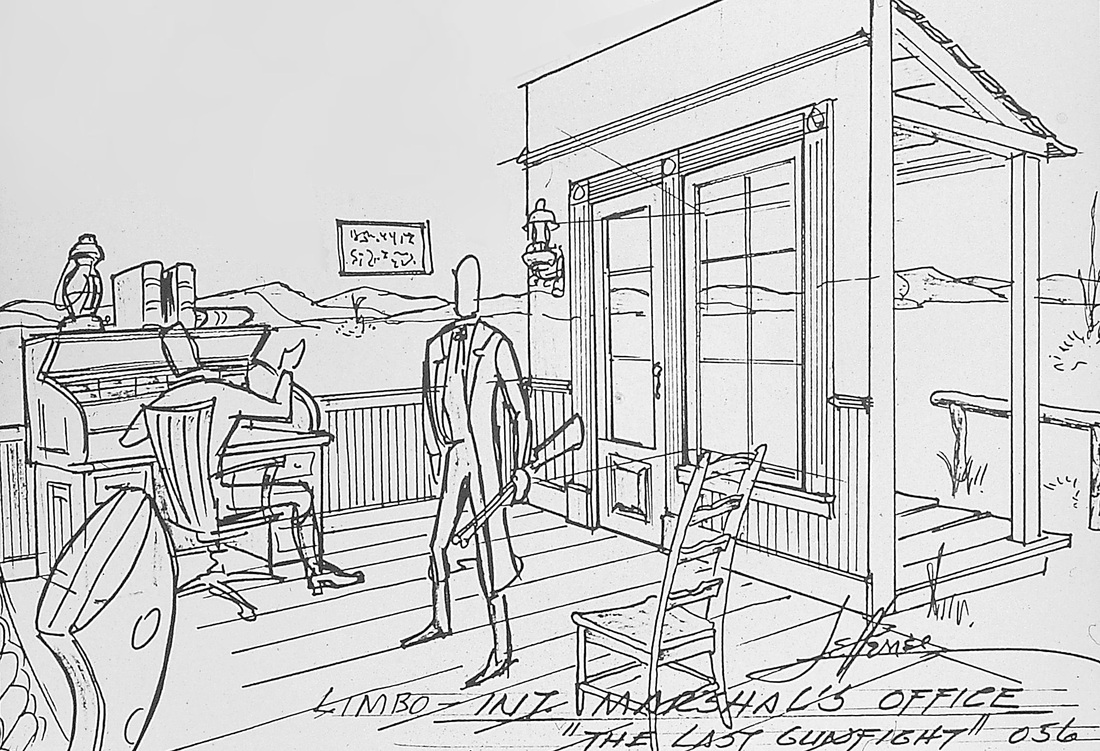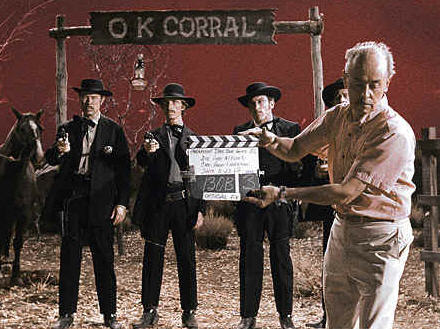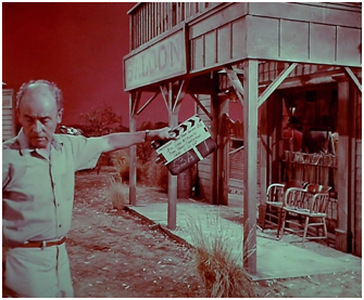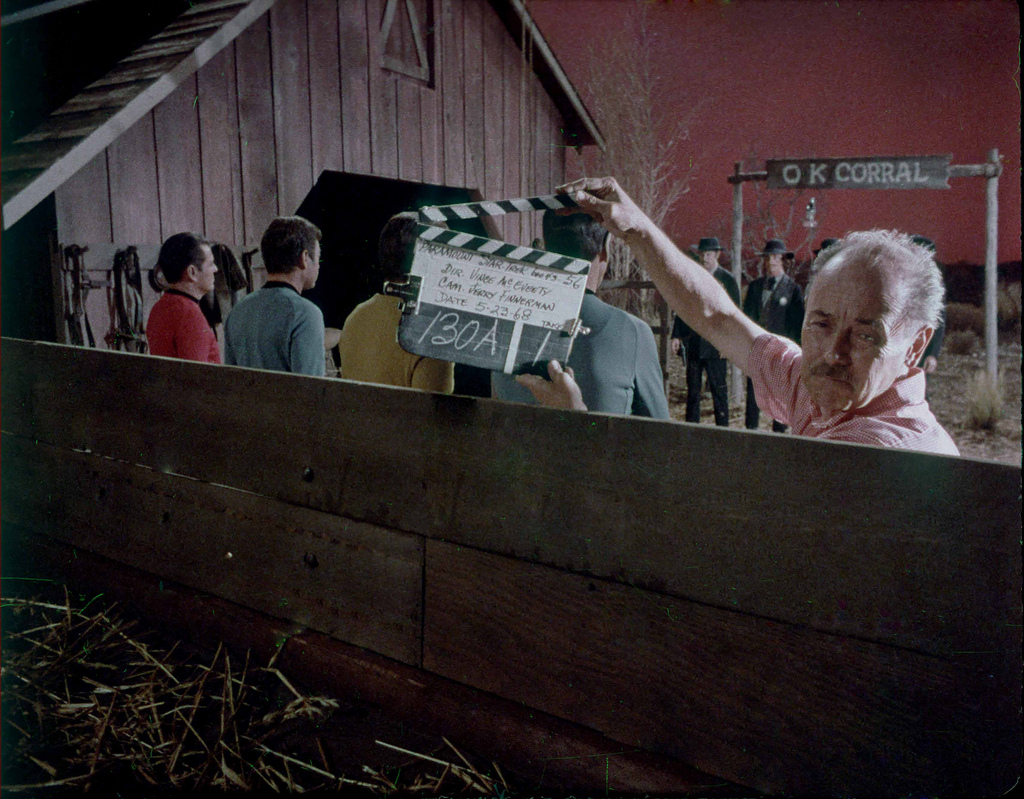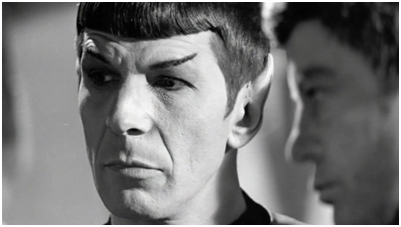|
The first episode filmed for Star Trek's third season was the highly imaginative and very surreal "Spectre of the Gun." In These Are the Voyages: TOS [The Original Series], Season Three, you will learn that the writer, Lee Cronin, was actually former Star Trek producer Gene Coon, and you'll discover the real reason he used a pseudonym while writing for the series during its third year. You'll also learn that this episode was called "The Last Gunfight," while being scripted and even while filming. The title change came later. You'll find out that NBC did not want this episode to film, but Gene Roddenberry, who assigned the script to Coon, pushed for it to go forward. And you'll learn that it was planned to be filmed on a Western town movie set, not on a sound stage with angry red skies, but budget concerns forced it indoors, and that this compromise actually added to the episode's appeal. Now, jump back in time with us to May 1968 for the filming of "The Last Gunfight."
|
Production Diary
Filmed May 21, 22, 23, 24, 27, 28 & 29, 1968.
(Planned 6 day production; finished 1 day over; total cost: $182,184.)
Filmed May 21, 22, 23, 24, 27, 28 & 29, 1968.
(Planned 6 day production; finished 1 day over; total cost: $182,184.)
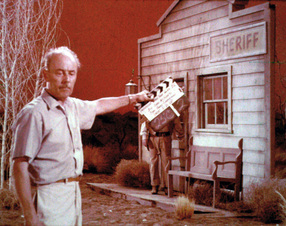 Bill McGovern slates the second take of scene 25 in the morning hours of Day 1 (Courtesy of Gerald Gurian)
Bill McGovern slates the second take of scene 25 in the morning hours of Day 1 (Courtesy of Gerald Gurian)
Filming began Tuesday, May 21, 1968. In the news, the nuclear-powered sub U.S.S Scorpion, with a crew of 99 men, was reported missing. It was later found at the bottom of the ocean near the Azores Islands, off Portugal. Robert Kennedy was the favorite for becoming the Democratic candidate for the presidential bid, and had the cover of both Newsweek and Time. Mike Connors of Mannix had the cover of TV Guide. The top rated series from the night before was The Andy Griffith Show, followed by The Lucy Show and Gunsmoke. All were on CBS. The No. 1 book in the nation was Airport, by Arthur Hailey. The soundtrack for The Graduate, by Simon and Garfunkel, was the top-selling record album in America, with the duo’s Bookends LP at No. 2. The Monkees had the third best seller, with The Birds, the Bees & the Monkees. Archie Bell & the Drells had the song getting the most play on radio stations, with “Tighten Up.” You could take the 45 home for about 70 cents.
|
The Emmy Awards had taken place over the weekend. Star Trek was up for Best Dramatic Series, and Outstanding Performance by an Actor in a Supporting Role in a Drama (Leonard Nimoy), as well as nominations for the Westheimer Company for its photographic effects in “Metamorphosis” and Donald Rode for his editing work in “The Doomsday Machine.” For the second year, William Shatner had not been nominated while his costar had, but no one on the set sensed any animosity directed by him toward Nimoy.
|
Day 1, Tuesday. Shatner, Nimoy, Kelley, Doohan, Koenig, and Star Trek veteran Paul Baxley (cast as a cowboy) had a surprise in store for them. So did guest players Bill Zuckert, Bonnie Beecher, and a third actor to be identified here only by his first name, Reece (as Morgan Earp this day, soon to be replaced). None could expect the sight they beheld when they walked onto Stage 10.
|
|
Producer Fred Freiberger said, “When Gene Coon wrote the original script, it was set in an actual western town. Bobby Justman and I thought about how we could help it some and therefore we did this surrealistic kind of town to try and give it an other-worldly approach.” (68-5)
C-Producer Bob Justman said, “I knew we were short on construction money; this was the first show of the third season and we were really trimmed down on budget by the studio, enormously, although our fixed expenses were going up due to casting escalations. We couldn’t afford to go out on location in the third season, that was gone -- so we had to figure out how to do a western town on stage and not make it cost too much.... So I had the idea of just using false fronts for the buildings in this so-called western landscape, and I also specified that the color of the sky be red -- an angry red.” (94-9) Director of Photography Jerry Finnerman said, “I’ll tell you, I lit that backing with the most beautiful red colors.… I was even awestruck by the way it looked.… Visually, that really knocked me out.” (63-3) |
It was Set Designer Matt Jefferies’ idea to have paintings and clocks suspended in space where a wall should have been. Shortly after the making of this episode, Jefferies said, “It wasn’t a true limbo -- it was a stylized limbo only in what wasn’t there. When you say ‘stylized limbo,’ you usually mean mis-balanced proportions, things hanging in space, etc.... It looked different, and it worked effectively.” (91-9)
Set Decorator John Dwyer said, “We had this big cyc [cyclorama] around the set, which is just a piece of cloth that you bounce light off of. And Jerry Finnerman decided he wanted a bunch of red light up on that. And he did that and it was very tough to know where you were -- to be distinctive -- because we were using just little pieces of a wall here and there. It was very surrealistic, because with all that red around, you didn’t know where you were.” (57-4)
First up on the production roster, the landing party’s arrival in the fragmented, windy western town, where Kirk, Spock, McCoy, Scott, and Chekov encounter Sheriff Behan (Zuckert). This scene went well and was a keeper. The next two would not work as well. Reece, as Morgan Earp, threw Paul Baxley from the saloon, and then shot him dead. Due to problems not yet apparent, Baxley would have to be shot dead again the next day. After this, Chekov sat on a bench outside the town store and flirted with Sylvia (Bonnie Beecher). And then he got shot dead by Morgan Earp (again, played by Reece). The sweet talk between Chekov and Sylvia was kept, the shooting was not.
Director Vincent McEveety recalled, “I had a major problem on that show. That was one of only two times that I can remember where I had to replace an actor.” (117-4)
Reece had read for the part and made an impression on McEveety who, otherwise, had chosen to book seasoned western actors whom he had worked with before. But Reece, with his first significant role on television, was unable to handle the challenge.
The production notes from that day in 1968 read:
Set Decorator John Dwyer said, “We had this big cyc [cyclorama] around the set, which is just a piece of cloth that you bounce light off of. And Jerry Finnerman decided he wanted a bunch of red light up on that. And he did that and it was very tough to know where you were -- to be distinctive -- because we were using just little pieces of a wall here and there. It was very surrealistic, because with all that red around, you didn’t know where you were.” (57-4)
First up on the production roster, the landing party’s arrival in the fragmented, windy western town, where Kirk, Spock, McCoy, Scott, and Chekov encounter Sheriff Behan (Zuckert). This scene went well and was a keeper. The next two would not work as well. Reece, as Morgan Earp, threw Paul Baxley from the saloon, and then shot him dead. Due to problems not yet apparent, Baxley would have to be shot dead again the next day. After this, Chekov sat on a bench outside the town store and flirted with Sylvia (Bonnie Beecher). And then he got shot dead by Morgan Earp (again, played by Reece). The sweet talk between Chekov and Sylvia was kept, the shooting was not.
Director Vincent McEveety recalled, “I had a major problem on that show. That was one of only two times that I can remember where I had to replace an actor.” (117-4)
Reece had read for the part and made an impression on McEveety who, otherwise, had chosen to book seasoned western actors whom he had worked with before. But Reece, with his first significant role on television, was unable to handle the challenge.
The production notes from that day in 1968 read:
|
Director Vincent McEveety asked producers to replace an actor because of many delays and inability to comprehend the scenes. It was learned from casting director Joe D’Agosta that the actor had personal problems which also affected his work. The producers decided to drop the actor from the production. The actor is to be paid the full amount of his contract. Due to recasting and retakes, the estimated production time lost was approximately three hours. (AD56-1)
|
This was the discreet way of stating the problem. McEveety, more candid when interviewed for this book in 2012, said, “The problem in my opinion was drugs. I had him in a scene with Bill Shatner; all he had to do was take a swing, and he had a couple lines. Now maybe this was something he’d never done, taking a swing at someone, but I had a stuntman there showing him what to do and when to do it, and he couldn’t even come close at doing that. He couldn’t come up with the lines, either. It’s too bad. I spent a lot of time with him. I had him in my dressing room, where I talked to him, I tried to reassure him that it’s a television show, it’s not the end of the world, let’s just do it, you know. But he couldn’t. He was on another planet. And I felt so sorry for him, because I loved his reading, and he seemed like a real nice guy, dedicated and everything, but evidently he needed some help to get there. That was his problem.” (117-4)
This casting problem caused an unintended ripple effect. Instead of hiring another actor to play Reece’s role as Earp, something else was considered.
This casting problem caused an unintended ripple effect. Instead of hiring another actor to play Reece’s role as Earp, something else was considered.
|
Rex Holman said, “[The] actor ... who was signed to do the role … got a bit too temperamental apparently, and Vincent McEveety fired him. So I went up a notch. There I was, sitting in the wings, and I thought, ‘Oh, my career is going to sail! This is my big break!’” (159-1)
McEveety said, “It put a big demand on Rex, switching roles like that with no notice, but I’d worked with him a lot and I knew he could do it. He was that good.” (117-4) McEveety, finishing one-quarter of a day behind, was forced to stop filming at 6:06 p.m. The new mandate from Paramount to Freiberger: no overtime allowed. |
Day 2, Wednesday. Stage 10. The production notes from the morning read:
|
Rex Holman was recast in the role of Morgan Earp, and Charles Maxwell was hired today for the role of “Virgil,” which Rex Holman originally had. (AD56-2)
|
|
First up, reshooting sequences from the day before.
McEveety continued to make significant contributions to the filming of the episode. His ideas were so off the norm, as were those of Coon, Justman, Jefferies, and Finnerman, that many members of the supporting cast were left feeling very much part of the limbo that surrounded them -- especially those hired to play the Earp brothers and Doc Holliday. They all knew McEveety, and they all knew westerns, but none were prepared for what they saw here. “It was a strange situation,” Ron Soble said. “Rex Holman, Charlie Maxwell, and I were hired to play the Earp boys, and then Sam Gilman was hired to play Doc Holliday. When we read the script, at least speaking for myself, it really looked like somewhat of a dog. And when we showed up on the set and saw the stylized buildings and so on and so forth, it seemed to be even more of a dud.” (159-2)
|
McEveety said, “The effects, the wind, the stylized sets -- the fragmented sets -- all make it feel like a stage play. It was the kind of thing that takes a lot of imagination to relate to.” (117-3)
After the retakes were finished, the company moved on to the OK Corral set and began filming the climactic shoot-out. For this scene, Ron Soble recalled how McEveety told him to play Wyatt Earp as if he were dead.
“I thought that was really strange direction,” Soble said. “Actually, though, that single suggestion turned out to be the key to my performance as Earp. The challenge was to animate this character enough so that he was interesting but, at the same time, keep him unanimated.... In the scene where I’m on my knees and William Shatner is going to shoot me, I’m using the ‘dead image’ approach.” (159-1)
Filming stopped at 6:12 p.m. McEveety was one-half day behind.
After the retakes were finished, the company moved on to the OK Corral set and began filming the climactic shoot-out. For this scene, Ron Soble recalled how McEveety told him to play Wyatt Earp as if he were dead.
“I thought that was really strange direction,” Soble said. “Actually, though, that single suggestion turned out to be the key to my performance as Earp. The challenge was to animate this character enough so that he was interesting but, at the same time, keep him unanimated.... In the scene where I’m on my knees and William Shatner is going to shoot me, I’m using the ‘dead image’ approach.” (159-1)
Filming stopped at 6:12 p.m. McEveety was one-half day behind.
|
Day 3, Thursday. This entire day was spent on the OK Corral set. Sam Gilman, as Doc Holliday, joined the cast and filming resumed with the gunfight. It was McEveety’s idea to have the fence behind Kirk, Spock, McCoy, and Scott be riddled with bullets, even though the Enterprise men are unscathed. This idea was not in the script. It worked beautifully.
McEveety finished the gun battle, but was now three-quarters of a day behind when filming stopped at 6 p.m. Day 4, Friday, May 24. On another part of Stage 10, scenes were filmed in the Barber Shop, inside and outside of the Marshal’s office, and then onto the street outside the saloon. |
|
For the latter, as the Earps and Doc Holliday walk through a windstorm toward the OK Corral, McEveety’s unexpected, unreal approach to filming continued. Ron Soble said, “Vince McEveety -- who was a very nice guy -- juxtaposed our positions. And it was all part of the design of the show to make it more of a surrealistic fantasy thing.... In one cut we are walking in one way, in terms of our relationship to one another, and then, in the next cut, for no reason at all, we were completely reversed, which didn’t make a lot of sense to us, but it made a lot of sense to him.” (159-2)
|
McEveety was a full day behind when filming stopped at 6:12 p.m. Another off-beat episode of Star Trek, “Catspaw” had its NBC repeat this night.
Day 5, Monday. The entire day was spent on the saloon set. The company got off to a late start. The production report stated:
Day 5, Monday. The entire day was spent on the saloon set. The company got off to a late start. The production report stated:
|
Shatner was 35 minutes late because his alarm clock didn’t go off, making him miss 7 a.m. call. Filming did not begin until 8:20 a.m. Crew [then] lost 20 minutes because of broken camera dolly. (AD56-3)
|
|
There was little McEveety could do. He held at one day behind, wrapping at 6:06 p.m.
Day 6, Tuesday. More work in the saloon, then off to “Ext. City Limits.” This was the scene where Kirk and his landing party try to leave town but discover there is a force field stopping them. A lost comedy sequence that was filmed, but didn’t make the final cut, had Kirk noticing a cowboy riding a horse through the invisible barrier, then deducing a horse might get him through, as well. He commandeers one and rides toward the force field. The horse makes it through, but Kirk does not, and is knocked off his ride for a hard landing on his backside. Actor Richard Anthony, billed as “Rider,” and Dick Dial, as Shatner’s stunt double, spent a few hours with McEveety filming the complex routine. But the “hard landing” ended up making a hard landing of its own, on the cutting room floor. |
Toward the end of the day, the company moved across to Stage 10 for the “Ext. Limbo” set. Special effects wizard Mike Minor, who also made specialty props and costumes, designed and built the Melkotian head that looks down on the landing party through thick fog. McEveety stayed one day behind, getting his last shot at 6 p.m.

Day 7, Wednesday, May 29. A full day on Stage 9, the Bridge set, for the filming of the episode’s Teaser and Tag scenes. McEveety wrapped at 5:30 p.m. Shatner and Nimoy stayed another 30 minutes to record audio promos for NBC, and then the camera crew shot a makeup test with actress France Nuyen in preparation for the episode to begin the next day.
Other than too much time and too much money spent, everyone associated with the series was happy with this kickoff for the Third Season.
“Vincent McEveety was a hell of a creative director,” Fred Freiberger said. “I thought he did some wonderful things with it.” (68-5)
Even with a compliment from the new man-in-charge, this was McEveety’s Star Trek swan song. He later said, “I liked Fred Freiberger a lot. I thought he was good. And I thought he liked me. But perhaps not, because it was not my choice to have that be my last assignment.” (117-4)
It wasn’t Freiberger’s choice either. Money, or lack of it, and pressure from Douglas Cramer’s office, would be the deciding factor.
Other than too much time and too much money spent, everyone associated with the series was happy with this kickoff for the Third Season.
“Vincent McEveety was a hell of a creative director,” Fred Freiberger said. “I thought he did some wonderful things with it.” (68-5)
Even with a compliment from the new man-in-charge, this was McEveety’s Star Trek swan song. He later said, “I liked Fred Freiberger a lot. I thought he was good. And I thought he liked me. But perhaps not, because it was not my choice to have that be my last assignment.” (117-4)
It wasn’t Freiberger’s choice either. Money, or lack of it, and pressure from Douglas Cramer’s office, would be the deciding factor.
Read about the making of all of the Season Three episodes of Star Trek: The Original Series in
These Are the Voyages: TOS, Season Three.
These Are the Voyages: TOS, Season Three.
While some of the images shown are in color, all images in the books are in black & white.


